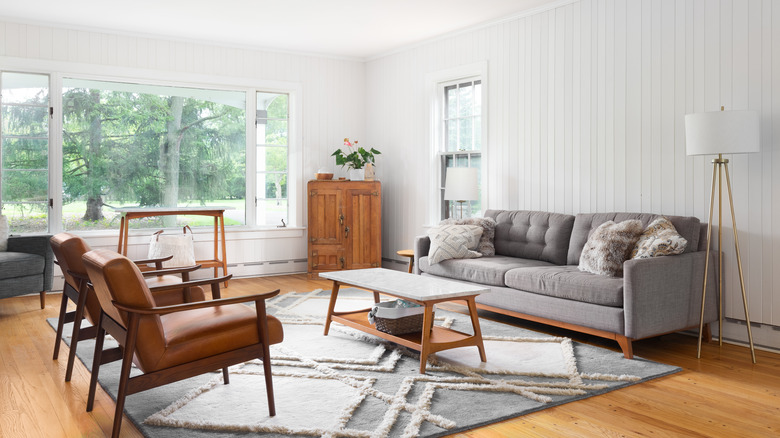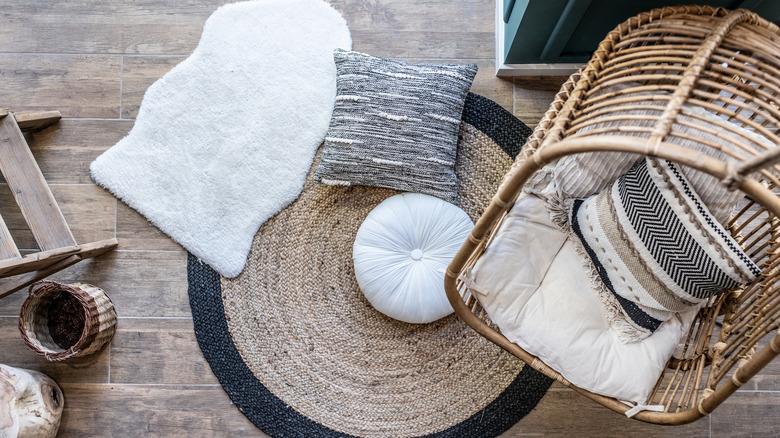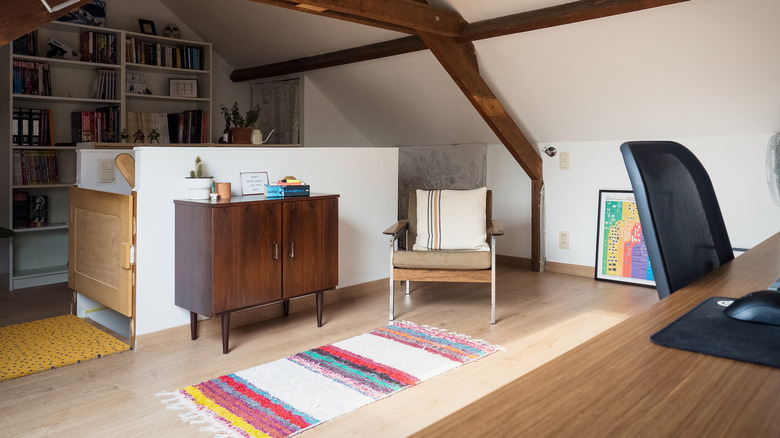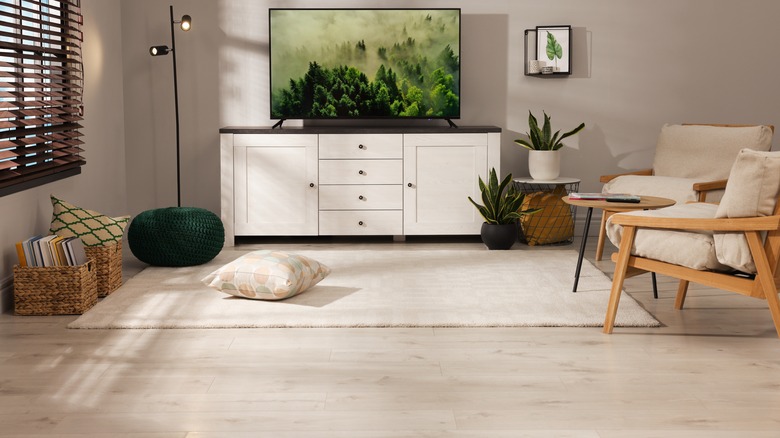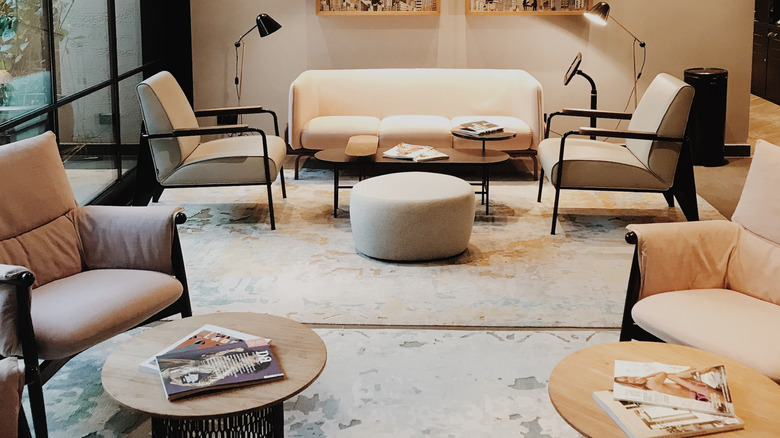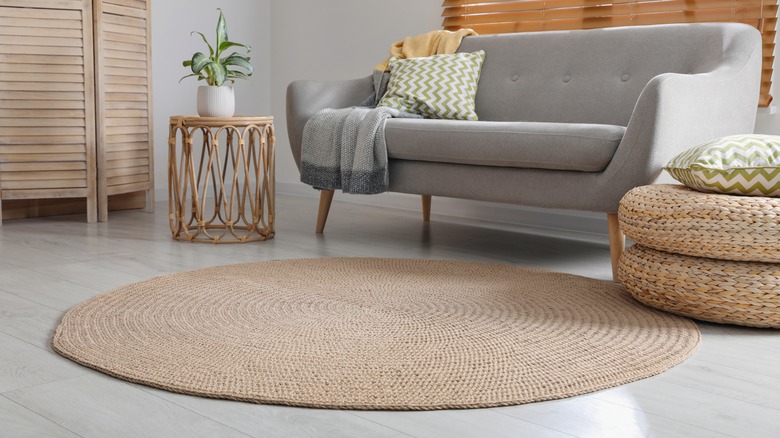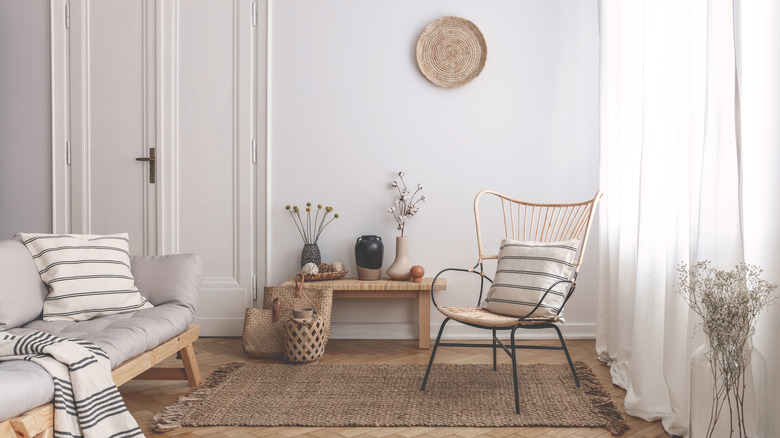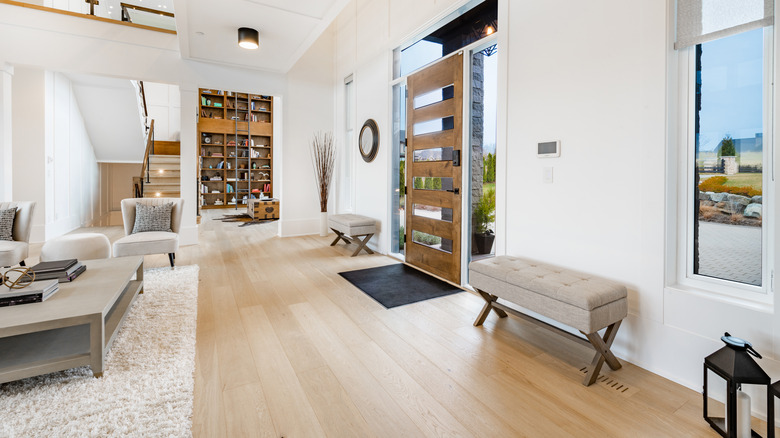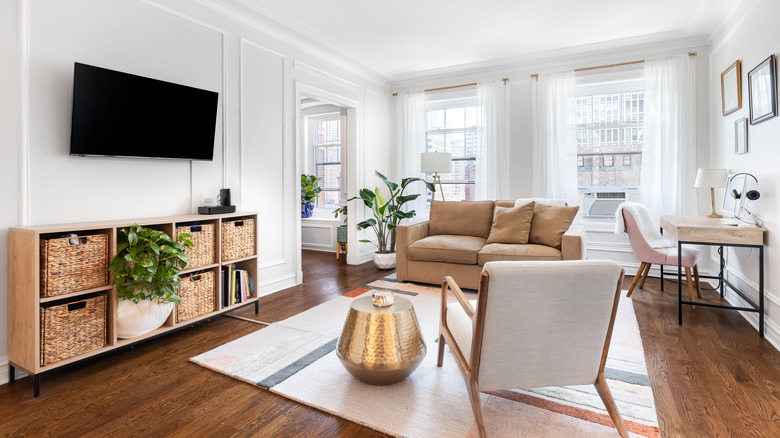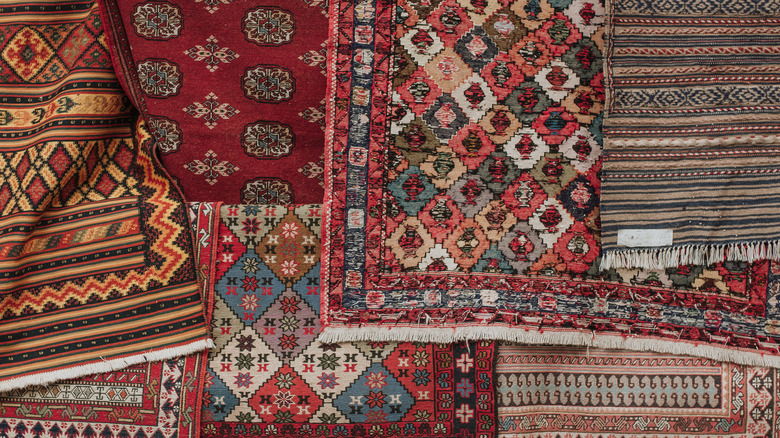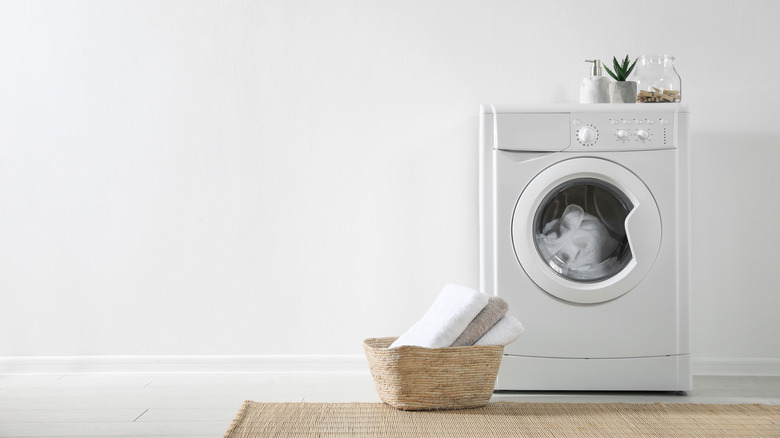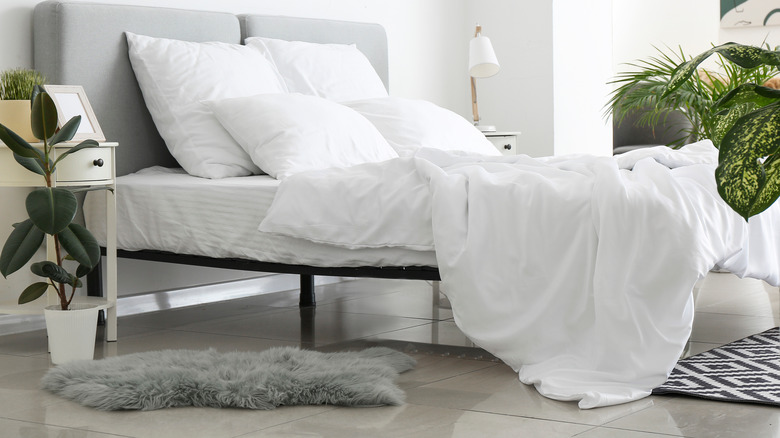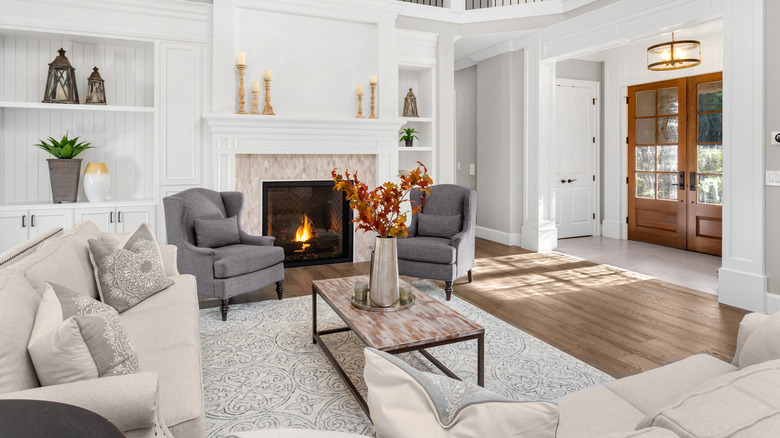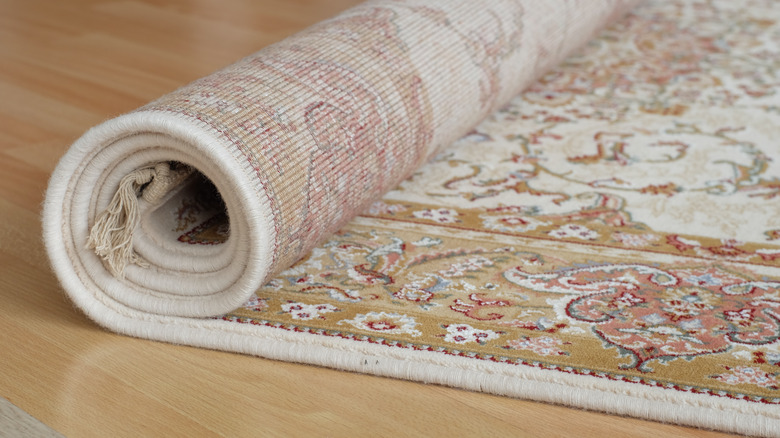Tips For Getting The Most Out Of Your Area Rugs
The perfect rug does exist, as long as you get the proportions right. According to Lilla Rugs, the rug placement on the floor should cover any negative space under the furniture or in the area. Take this into account when shopping for your next living room rug. It is essential to be concise with the measurements to ensure you purchase the right sized area rug for your space. Then it's time for the best parts, including the color choice, design layout, pattern, and fabric decisions that go into picking out the perfect area rugs for your home. Before making any final decisions, ponder what materials and forms will go best in your space. You ultimately want this floor investment to be around for a while and possibly use it in other rooms.
Adding a single accent rug to a room is common, but have you ever considered two? Whether you choose one or more area rugs for your rooms is a personal design decision guaranteed to shift the appearance of a space. To get the most out of the rugs in your home, maintain their beauty, expand their lifespan, and make them comfortable. Continue reading for tips to get the most out of your current and future rugs.
Layer them on top of one another
An interior designer-inspired technique to elevate a space in your home is to stack the area rugs on top of one another. Imagine two rectangular carpets of different sizes peeking out from under the sectional sofa or bed frame. This dual area rug placement adds a level of complexity to the interior of your home that you do not get with one area rug. It also allows you to showcase two designs you adore in one room.
When layering two rugs together, it is important to note each one's size, as this will give you an idea of how much area will be exposed. According to Studio McGee, it's best to use a rug about ⅔ the size of the carpet underneath to achieve a balance. This measurement ensures that the rug underneath will show. The point of layering rugs is to add dimension to the flat surface, not cover up the entire piece below.
Choose cohesive colors
Typically area rugs are one of the last items added to a room because it takes time to establish a color base. Once you know what colors you will be highlighting in your home, you will be more than ready to find the right accent rug for any room. As per MyMove, you should select an area rug with at least two of your home's accent colors. This attention to detail will integrate all the other elements effortlessly. This concept is ideal for an open floor plan or when using a similar color palette throughout the entire home.
Choosing area rugs with similar accent shades helps unify a color palette and provides transitional functionality. A decorator will be able to transfer the area rug to different parts of the house if and when they desire, as long as the color reflected in the rug pairs well with the existing ones in the space. You can use a living room rug in the den or a hallway rug at the entryway. The placement options are limitless when the colors remain cohesive.
Mix rugs in the same room
No decorating rule mandates that you can only have one rug per room. Instead, a decorator can choose to blend several in the same space and leave a unique mark. Unlike wall colors, area rug colors that contrast too much will clash and make the overall design muddled. To prevent this, mix rugs with similar tones and complementary features. These attributes will allow the pieces to exist in unity in your space.
Mixing rugs can be simple if you pair similar color saturation and shade. According to Brick + Beam Studio, you can mix different rug styles and materials, such as cowhide and natural styles or ones with bold patterns and significant textural elements. Linking several opposing area rugs in one space adds dimension and character to the otherwise flat room. If you have an open layout home, displaying area rugs can link the spaces together.
Get the right size
The number one challenge most decorators face when rug shopping? Choosing a rug that's the right size for the room. "Scale is always in the forefront of my mind when selecting a rug," says designer Bruce Fox to Martha Stewart. "It's the thing to 'get right' in a living room." When shopping, the motto to keep in mind is, the bigger, the better. If you think it is too small, then it is too small! You want the rug to cover most of the floor in the space so it can elevate the furnishings and the room. A small rug will negatively distort the proportions, while one that's too large will not fit.
When it comes to rug shopping, nothing matters more than the size of the rug you choose for your space. Try to get it right the first go-around. How can you be sure you choose the right one for your room? Measure and then measure it again. Typically you want to have "even margins all around — usually between eight to 12 inches," shares Fox. The uniformity in the design will help establish a cohesive layout in the room.
Same rug, same room
If finding a complementary rug is not panning out, keep it simple and match your rugs, per Overstock. Yes, duplicate your area rug choice in the same room. This pattern repetition introduces an elegant and modern twist to your space. The rugs can be at opposite ends of the room and do not necessarily have to touch for this trick to work. If you have a living room layout with two sofas facing one another, you could layer the same style rug under each one to help frame the sofas and add dimension to the space.
You can create a more abstract floor space by purchasing the same rug pattern in two different sizes. Consider pairing a 5x7-inch rug with the same design, just in a larger size, such as 7x10-inch. Most manufacturers make multiple sizes in the same rug pattern, color, and style, making this decorative format possible for any design preference. This concept allows you to focus on selecting a single design to enhance your home design rather than introducing multiple variations.
Select the right shape for your space
Assuming you are searching for a large rug for a living room or bedroom area, it is a high possibility that furniture will go on top. According to Ruggable, whether the space is open or enclosed, the shape of the rug you choose needs to be appropriate to frame the furniture on top. You want to coordinate the area rug shape with existing furnishings in the room, including any sofas, couches, coffee tables, accents, chairs, stools, or end tables. Consider items that will touch the area rug when making decisions for the rug shape.
If you seek a more budget-conscious option or the size is unavailable for your space, you can always layer several rugs into the room with different shapes. This technique is ideal for decorators willing to allow more parts of their hardwood flooring to peek through. You can lay a rectangular-shaped area rug in one part of the room and a circular shape with different materials elsewhere. The shapes are drastically different, but the hues and material should be compatible.
Types of rugs that will last
Choose durable and long-lasting materials to get the absolute most out of your area rugs. According to Better Homes & Gardens, you should understand how to make wise material selections when selecting a rug for your home. Popular rug types are shag, knotted, woven, braided, tufted, and hooked. The style you choose will depend on the specific needs of your household and the pattern of foot traffic. High-traffic areas of the home require a durable material, while you can decorate less-used spaces with more delicate floor coverings.
How do you determine which area rug style is for your room? You can begin by considering your lifestyle. The amount of use a rug will receive in your home will help you choose the right style. Tightly woven or high-knot count rugs are ideal in areas like living rooms, stairways, and bedrooms. Popular rug materials include synthetic fibers, wool, silk, viscose, and jute.
Fit its function for proper flow
There are plenty of common mistakes people make when choosing a new rug. An integral step in the area rug selection process is deciding what function it will serve in your desired space. Area rugs have different purposes that factor into shape and style decisions. Where you choose to layer this accent item will determine the flow of your floor plan. According to The Home Depot, you can ensure cohesive function and form by maintaining at least 6 inches of floor space around the area rug. A rug covering too much of the floor will clutter the design and make the aesthetic feel out of balance.
Hallways, laundry rooms, kitchens, and entryways can be the most constrictive parts of the home for area rug dimensions. The wall area and narrow designs may require specific area rugs. Using area rugs to decorate these parts plays a vital role in determining traffic patterns and visual interest, as the entire rug is often exposed. Use rugs in these rooms to make a decorative focal point.
Use a liner underneath
Area rugs are the floor decoration you never knew you needed. If you are searching for one for a room in your house, know there is an additional layer of support you can lay down to increase comfort. While rugs often feature soft and plush material, they can always be softer. How do you get this added softness on your flooring? You add a rug pad under the area rug. "You always need a rug pad," says designer Greg Roth to Better Homes & Gardens. "Rugs wear from the bottom up, so the pad is essential to protecting the fibers from constant abrasion." What? Rugs wear from the bottom, too? Yes. Area rugs not only get stepped on from above or carry the weight of furniture on their back, but the constant pressure also wears down the fibers that touch the floors.
Using this additional soft layer under an area rug offers many benefits. It makes the rug feel comfortable on the toes and keeps it in place. The best materials under an area rug include rubber and felt (via The Spruce). These pads help fix the rug to a semi-permanent place without carpet tape. This tip is ideal for hallway and entryway area rugs where the furniture does not assist in keeping the position.
Lay them side by side
Sometimes a room's shape will limit the rug options you can select from to cover the floor. "Ideally, the rug's edges should be 12 to 14 inches from the perimeter," shares designer Sarah Richardson to Good Housekeeping. If your space is narrow, "consider laying them side by side." If your desired shape is not available in a specific size or if you want a more budget-friendly option, consider pairing rugs in the same room. Luckily, there are plenty of sizes and shapes available. When one is not enough, consider two! This coupling will elongate the area rug's appearance, allowing you to find a better use for it and mold it to fit your room's shape.
You can keep the exact patterns and purchase two of the same size rug in the same design. If you're looking for more contrast and visual texture in your room, switch it up and find two rugs compatible in form and color but independent in pattern and detail. The key to a successful joint display of area rugs is creating the appearance they belong together. Be mindful of the carpet's edges and try to find ones of the same finish. If this is not possible, you can cover the seam of the two area rugs with a piece of furniture.
Keep it clean
While the shape, color, and size are all essential when choosing an area rug, the key to getting the most out of it is the upkeep. Daily use, especially in high-traffic areas, will make the fibers wear down faster. The placements of the area rugs also make them prone to more spillage, resulting in them becoming dirtier faster. You want to maintain your area rug's vitality by keeping it in the best shape. How do you do that exactly? By cleaning it with a homemade solution such as dish soap and warm water, per The Spruce.
While the simple cleaning solution is one part of the upkeep, the other is the cleaning technique. The most gently preferred method for cleaning your large area rug is blotting. When cleaning a stain, it's best to blot, blot, and blot the spot without vigorously rubbing. The gentle blotting will preserve the delicate fibers in the rug and prevent any shredding or pulling. It's advisable to avoid stiff brushes and bristles.
Material makeup matters
Some of the most expensive rugs feature different fiber combinations that create a luxurious feel and ultra-smooth texture underneath your toes. Those materials are essential to note when searching for the perfect area rug for your dwelling. What the area rug is composed of will factor into whether or not it is suitable for you and your home. Blended rugs feature materials that require different care processes, some more challenging than others. For example, silk and wool are popular area rug combinations, but this delicate structure can be costly to clean and maintain. "When you have silk-and-wool mixes, it creates hard-to-sort problems once there's a spill," said Celerie Kemble to The New York Times.
To get the most out of your floor purchase, become familiar with what it will take to upkeep the rug's materials. Maintenance can be relatively simple if the rug is composed of a single material like nylon, wool, polypropylene, and sisal. These materials are durable and easy to clean. The lowkey maintenance is ideal for the everyday homeowner and looks good in your residence.
Rotate the rug
This home care styling technique is one you need to adapt sooner rather than later, as this method can extend the life of your accent rugs in your home today. According to The Martha Stewart Blog, you should rotate a piece at least once a year to ensure even use. You can instantly refresh the fibers under your feet by rotating the rug, exposing the covered parts, and covering the exposed ends. This rug rotation in your home will allow the carpet fibers to receive equal wear and tear and prevent either side from wearing faster.
Moving rugs to expose other portions will also help prevent discoloration if the rug has color. Shuffling the carpets around may pose other decorative advantages. This shift may give your space a whole new look. If your rug has an abstract or marble effect, one portion of it may have a different depiction compared to the other half. The subtle change created using the same rug may give your space a little unexpected lift.
Let them rest
While rotating rugs will ensure all the fibers receive equal wear and tear, you can roll the entire carpet up for a no wear, no tear care option. If you have space to store the area rug, go ahead and move the furniture off the carpet, give it a good cleaning, and roll it up. "Changing the area rugs for the summer gives a whole new look," shares interior designer Linda Yepez to Westchester Magazine. Seasonally swapping rugs is common in household designs since it freshens the landscape and gives the area rug a much-needed break from daily foot traffic. This method will increase its longevity, allowing you to enjoy it the next time you roll it out in a room.
An area rug can positively complete a design. The edges create structure and add form, while the patterns introduce movement and allow the colors a chance to make everything whole. Area rugs are a top home feature. This home decoration investment can last years and years with the correct maintenance and care. After choosing the perfect size, color and shape, be mindful of the material and adapt regular routines for fiber care. Regular care will preserve its magnificence and help you get the most out of your area rug.
